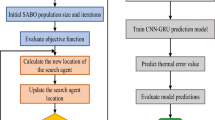Abstract
Thermal deformation in machine tools is one of the most significant causes of machining errors. A new approach to predict the thermal error of machine tool is proposed. The temperature variables and the thermal errors are measured using the Pt-100 thermal resistances and eddy current sensors respectively. Fuzzy c-means clustering method is conducted to identify the temperatures, and the representative as an independent variable are selected meanwhile it eliminates the coupling among the variables. The learning and prediction of the thermal errors is achieved using minimal-resource allocating networks by treating the issue as functional mapping between the thermal shifts and the temperature variables. The network is made to predict the error map of a machining center. A traditional radial basis function model is introduced for comparison. The experiment result shows that the fuzzy c-means clustering method and minimal-resource allocating networks combination is a fast and accurate method for thermal error compensation in machine tools.
Similar content being viewed by others
References
Ni J (1997) CNC machine accuracy enhancement through real-time error compensation. J Manuf Sci E-T Asme 119(4B):717–725
Bryan J (1990) International status of thermal error research. CIRP Ann-Manuf Technol 39(2):645–656
Srivastava AK, Veldhuis SC, Elbestawit MA (1995) Modeling geometric and thermal errors in a 5-axis CNC machine-tool. Int J Mach Tool Manuf 35(9):1321–1337
Wang SM, Liu YL, Kang Y (2002) An efficient error compensation system for CNC multi-axis machines. Int J Mach Tool Manuf 42(11):1235–1245
Kim SK, Cho DW (1997) Real-time estimation of temperature distribution in a ball-screw system. Int J Mach Tool Manuf 37(4):451–464
Yun WS, Kim SK, Cho DW (1999) Thermal error analysis for a CNC lathe feed drive system. Int J Mach Tool Manuf 39(7):1087–1101
Choi JK, Lee DG (1998) Thermal characteristics of the spindle bearing system with a gear located on the bearing span. Int J Mach Tool Manuf 38(9):1017–1030
Zhao HT, Yang JG, Shen JH (2007) Simulation of thermal behavior of a CNC machine tool spindle. Int J Mach Tool Manuf 47(6):1003–1010
Chen JS, Chiou G (1995) Quick testing and modeling of thermally-induced errors of CNC machine-tools. Int J Mach Tool Manuf 35(7):1063–1074
Kang Y, Chang CW, Huang YR, Hsu CL, Nieh IF (2007) Modification of a neural network utilizing hybrid filters for the compensation of thermal deformation in machine tools. Int J Mach Tool Manuf 47(2):376–387
Li YX, Yang JG, Gelvis T, Li YY (2008) Optimization of measuring points for machine tool thermal error based on grey system theory. Int J Adv Manuf Technol 35(7-8):745–750
Yan JY, Yang JG (2009) Application of synthetic grey correlation theory on thermal point optimization for machine tool thermal error compensation. Int J Adv Manuf Technol 43(11-12):1124–1132
Yang S, Yuan J, Ni J (1996) The improvement of thermal error modeling and compensation on machine tools by CMAC neural network. Int J Mach Tool Manuf 36(4):527–537
Lee DS, Choi JY, Choi DH (2003) ICA based thermal source extraction and thermal distortion compensation method for a machine tool. Int J Mach Tool Manuf 43(6):589–597
Srinivasa N, Ziegert JC (1997) Prediction of thermally induced time-variant machine tool error maps using a Fuzzy ARTMAP neural network. J Manuf Sci E-T Asme 119(4A):623–630
Li X (2001) Real-time prediction of workpiece errors for a CNC turning centre. Part 2. Modelling and estimation of thermally induced errors. Int J Adv Manuf Technol 17(9):654–658
Ramesh R, Mannan MA, Poo AN, Keerthi SS (2003) Thermal error measurement and modelling in machine tools. Part II. hybrid Bayesian network—support vector machine model. Int J Mach Tool Manuf 43(4):405–419
Li JW, Zhang WJ, Yang GS, Tu SD, Chen XB (2009) Thermal-error modeling for complex physical systems: the-state-of-arts review. Int J Adv Manuf Technol 42(1-2):168–179
Guo QJ, Yang JG (2011) Application of projection pursuit regression to thermal error modeling of a CNC machine tool. Int J Adv Manuf Technol 55(5-8):623–629
Guo QJ, Yang JG, Wu H (2010) Application of ACO-BPN to thermal error modeling of NC machine tool. Int J Adv Manuf Technol 50(5-8):667–675
Bezdek JC (1981) Pattern recognition with fuzzy objective function algorithms. Plenum Press, New York
Schwammle V, Jensen ON (2010) A simple and fast method to determine the parameters for fuzzy c-means cluster analysis. Bioinformatics 26(22):2841–2848
Miyamoto S, Ichihashi H, Honda K (2008) Algorithms for fuzzy clustering: methods in c-means clustering with applications. Springer, Berlin
Yang ZY, Sun ML, Li WQ, Liang WY (2011) Modified Elman network for thermal deformation compensation modeling in machine tools. Int J Adv Manuf Technol 54(5-8):669–676
Judd JS (1990) Neural network design and the complexity of learning. MIT Press, Cambridge
Lu YW, Sundararajan N, Saratchandran P (1998) Performance evaluation of a sequential minimal radial basis function (RBF) neural network learning algorithm. IEEE Trans Neural Network 9(2):308–318
Author information
Authors and Affiliations
Corresponding author
Rights and permissions
About this article
Cite this article
Han, J., Wang, L., Cheng, N. et al. Thermal error modeling of machine tool based on fuzzy c-means cluster analysis and minimal-resource allocating networks. Int J Adv Manuf Technol 60, 463–472 (2012). https://doi.org/10.1007/s00170-011-3619-5
Received:
Accepted:
Published:
Issue Date:
DOI: https://doi.org/10.1007/s00170-011-3619-5




